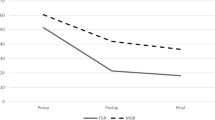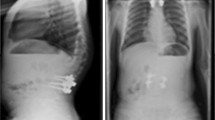Abstract
Purpose
Non-invasive distraction of magnetically controlled growing rods (MCGR) avoids repeated surgical lengthening in patients with early onset scoliosis, but it is not known how effective this technique is in previously operated children.
Methods
In a retrospective, multicentre study, the data were obtained for 27 primary (P) patients [mean age 7.0 (2.4–10.7) years at surgery] and 23 conversion (C) patients [mean age 7.7 (3.6–11.0) years at conversion from standard growing rods] with 1-year follow-up.
Results
The mean major curve was 63.9° in the P group and 46.5° in the C group at baseline (preoperatively, p = 0.0009) and 39.5° and 39.6°, respectively, at 1-year follow-up (p = 0.99). The mean percentage change of spinal growth from baseline to 1-year follow-up was 18.3 % in the P group and 6.5 % in the C group (p = 0.007). Comparing the spinal growth from postoperative to 1-year follow-up no statistical difference was observed between the study groups (1.8 % P vs −2.2 % C, p = 0.09).
Conclusions
Scoliosis can be equally controlled after conversion from traditional growing rods into MCGR, but spinal growth from baseline is less in the conversion patients as compared with the primary group.
Level of evidence
III.

Similar content being viewed by others
References
Williams BA, Matsumoto H, McCalla DJ et al (2014) Development and initial validation of the Classification of Early-Onset Scoliosis (C-EOS). J Bone Joint Surg [Am] 96:1359–1367
Akbarnia BA (2007) Management themes in early onset scoliosis. J Bone Joint Surg [Am] 89-A(Suppl 1):42–54
Fernandes P, Weinstein SL (2007) Natural history of early onset scoliosis. J Bone Joint Surg [Am] 89-A:21–33
Pehrsson K, Larsson S, Oden A, Nachemson A (1992) Long-term follow-up of patients with untreated scoliosis. A study of mortality, causes of death, and symptoms. Spine 17:1091–1096
Karol LA, Johnston C, Mladenov K et al (2008) Pulmonary function following early thoracic fusion in non-neuromuscular scoliosis. J Bone Joint Surg [Am] 90-A:1272–1281
Akbarnia BA, Breakwell LM, Marks DS et al (2008) Dual growing rod technique followed for 3–11 years until final fusion: the effect of frequency of lengthening. Spine 33:984–990
McCarthy RE, Luhmann S, Lenke L, McCullough FL (2014) The Shilla growth guidance technique for early-onset spinal deformities at 2-year follow-up: a preliminary report. J Pediatr Orthop 34:1–7
Lenke LG, Dobbs MB (2007) Management of juvenile idiopathic scoliosis. J Bone Joint Surg [Am] 89-A(Suppl. 1):55–63
Hasler CC, Mehrkens A, Hefti F (2010) Efficacy and safety of VEPTR instrumentation for progressive spine deformities in young children without rib fusions. Eur Spine J 19:400–408
Murphy RF, Moisan A, Kelly DM et al (2016) Use of Vertical Expandable Prosthetic Titanium Rib (VEPTR) in the treatment of congenital scoliosis without fused ribs. J Pediatr Orthop 36(4):329–335
Dannawi Z, Altaf F, Harshavardhana NS et al (2013) Early results of a remotely-operated magnetic growth rod in early-onset scoliosis. Bone Joint J 95-B:75–80
Cheung KM, Cheung JP, Samartzis D et al (2012) Magnetically controlled growing rods for severe spinal curvature in young children: a prospective case series. Lancet 379:1967–1974
Hickey BA, Towriss C, Baxter G et al (2014) Early experience of MAGEC magnetic growing rods in the treatment of early onset scoliosis. Eur Spine J 23:61–65
Sankar WN, Skaggs DL, Yazici M et al (2011) Lengthening of dual growing rods and the law of diminishing returns. Spine (Phila Pa 1976 36:806–809
Campbell RM Jr, Smith MD, Mayes TC et al (2003) The characteristics of thoracic insufficiency syndrome associated with fused ribs and congenital scoliosis. J Bone Joint Surg Am 85-A:399–408
Akbarnia BA, Cheung K, Noordeen H et al (2013) Next generation of growth-sparing techniques: preliminary clinical results of a magnetically controlled growing rod in 14 patients with early-onset scoliosis. Spine (Phila Pa 1976) 38:665–670
Flynn JM, Tomlinson LA, Pawelek J et al (2013) Growing-rod graduates: lessons learned from ninety-nine patients who completed lengthening. J Bone Joint Surg 95-A:1745–1750
Rolton D, Richards J, Nnadi C (2014) Magnetic controlled growth rods versus conventional growing rod systems in the treatment of early onset scoliosis: a cost comparison. Eur Spine J 24(7):1457–1461
Kabirian N, Akbarnia BA, Pawelek JB et al (2014) Deep surgical site infection following 2344 growing-rod procedures for early-onset scoliosis: risk factors and clinical consequences. J Bone Joint Surg Am 96-A:e128
Yoon WW, Sedra F, Shah S et al (2014) Improvement of pulmonary function in children with early-onset scoliosis using magnetic growth rods. Spine 39:1196–1202
Noordeen HM, Shah SA, Elsebaie HB et al (2011) In vivo distraction force and length measurements of growing rods: which factors influence the ability to lengthen? Spine 36:2299–2303
Acknowledgments
The authors thank Leslee Willes, MS, Willes Consulting Group, Incorporated for assistance with statistical analysis. We are Grateful to Mr. MH Hilali Noordeen, MA, DM, FRCS (Tr and Orth), MCh—Consultant spinal surgeon based at The Royal National Orthopaedic Hospital NHS Trust, Stan and University College of London, England—United Kingdom without whose guidance, we would not have been able to prepare this manuscript for publication in its current form.
Author information
Authors and Affiliations
Corresponding author
Rights and permissions
About this article
Cite this article
Keskinen, H., Helenius, I., Nnadi, C. et al. Preliminary comparison of primary and conversion surgery with magnetically controlled growing rods in children with early onset scoliosis. Eur Spine J 25, 3294–3300 (2016). https://doi.org/10.1007/s00586-016-4597-y
Received:
Accepted:
Published:
Issue Date:
DOI: https://doi.org/10.1007/s00586-016-4597-y




